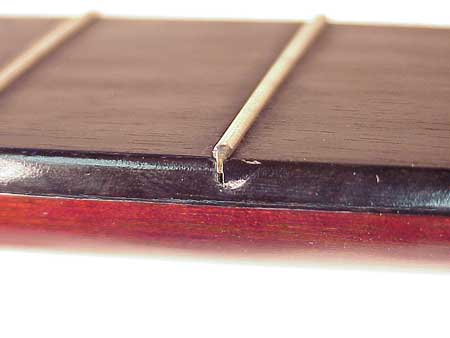Oh, yes, while I'm on the subject of wear, take a look at this fingerboard:

Very little fret wear here, but lots of fingernail divots in the fretboard. No big deal, though, because fingerboard wear never interferes with playability or longevity. Such wear is purely "cosmetic" and there's no need to anything about it.
Wear isn't the only cause of uneven frets. Sometimes a fret will be too high because it just isn't seated properly, or becomes loose with time, age or fingerboard shrinkage caused by dryness. A fret might be too low because of being tapped too hard during installation, or by being injured when a guitar tips out of its stand and falls against a hard object.
Presuming that the truss rod is correctly adjusted and that the neck of the guitar is reasonably straight, it's not difficult to locate a high or low fret. I gaze down the length of the neck from the peghead to the bridge, lining up the frets in my sight, looking for ones that appear lighter or darker in reflected light. Often, I can spot a light one (sticking up too high) or a dark one (too low).
Often, the loose fret end will be visible from the side:

It's not uncommon for loose fret ends to snag the first string if it should slip off the edge of the fingerboard during playing.
A short straightedge will "rock" over a high fret. If the straightedge is just long enough to span only three frets, it's no big trick to find a low or high one by trying to rock the straightedge back and forth. What appears at first to be a too high fret may, in fact, be a fret whose neighbor is too low.
This little precision straightedge is made with three very flat sides so I can span just three frets anywhere on the neck:

With this little tool, I can find that high or low bugger in a hurry!
No question about it, uneven frets can be a nightmare for the picker. If your guitar buzzes terribly in certain fret positions only, uneven frets would be a good first guess. If you'd like lots more information about buzzing and related problems, check out the "Buzz Diagnosis Page" where you'll find two dozen descriptions of what can cause this kind of misery.
High frets can be tapped down, and sometimes glued in position, and low frets can be raised or replaced with taller ones. If there are lots of loose, uneven frets, then it's generally best to refret the instrument, to avoid excessive leveling.
If you look under the straightedge in this photo, you'll see that the fret has a nice, rounded top:

A straightedge really aids in viewing the profile of a fret. It casts shadows that really highlight the rounded shape of the fret crown. This nice, tall, rounded fret will give good contact for the string.
Now, look at this one:

The top of this fret is completely flat from excessive leveling without "re-crowning" or rounding the top afterward. It's no coincidence that flat frets and low frets are often one and the same, because they have the same cause.
The effect of flat frets is that the string can't get a single point contact so it may actually flap against the flat top of the frets, causing a dull or "fuzzy" tone. Add that bit of nastiness to the fact that low frets make fretting difficult, and you have a couple of good reasons for replacing the frets.
Flat frets don't allow the string to make contact in the center of the fret, so intonation is likely to suffer as well. Intonation is another casualty of the low fret syndrome as the player presses so hard that the string stretches sideways a bit from lack of control brought on by all that effort.
Really wide frets (over .100") have been popular among electric players, but lots of acoustic guitarists feel such frets are more likely to contribute to a dulling of tone because the string doesn't have as much of a "point contact" on the top of the rounded fret. Such frets are likely to wear more broadly and become flatter as they wear, too.
As guitars age or as they are subjected to excessive heat or dryness, their fingerboards may shrink a little. As the fingerboard shrinks, the ends of the frets begin to stick out a little. It takes only a few thousandths of an inch for a protruding fret to feel really sharp on the old left hand (or right hand for some).
This Martin D-28 is only a few years old, but it spent some time in a hot parked car:

See how that fret actually poked a flake of ebony right off the edge of the fingerboard? Well, that fret and its 19 compatriots feel like so many little knife points when you run your hand along the fingerboard!
As if we needed it, loose and protruding frets make another fine reason to avoid leaving a guitar in a hot parked car. . .